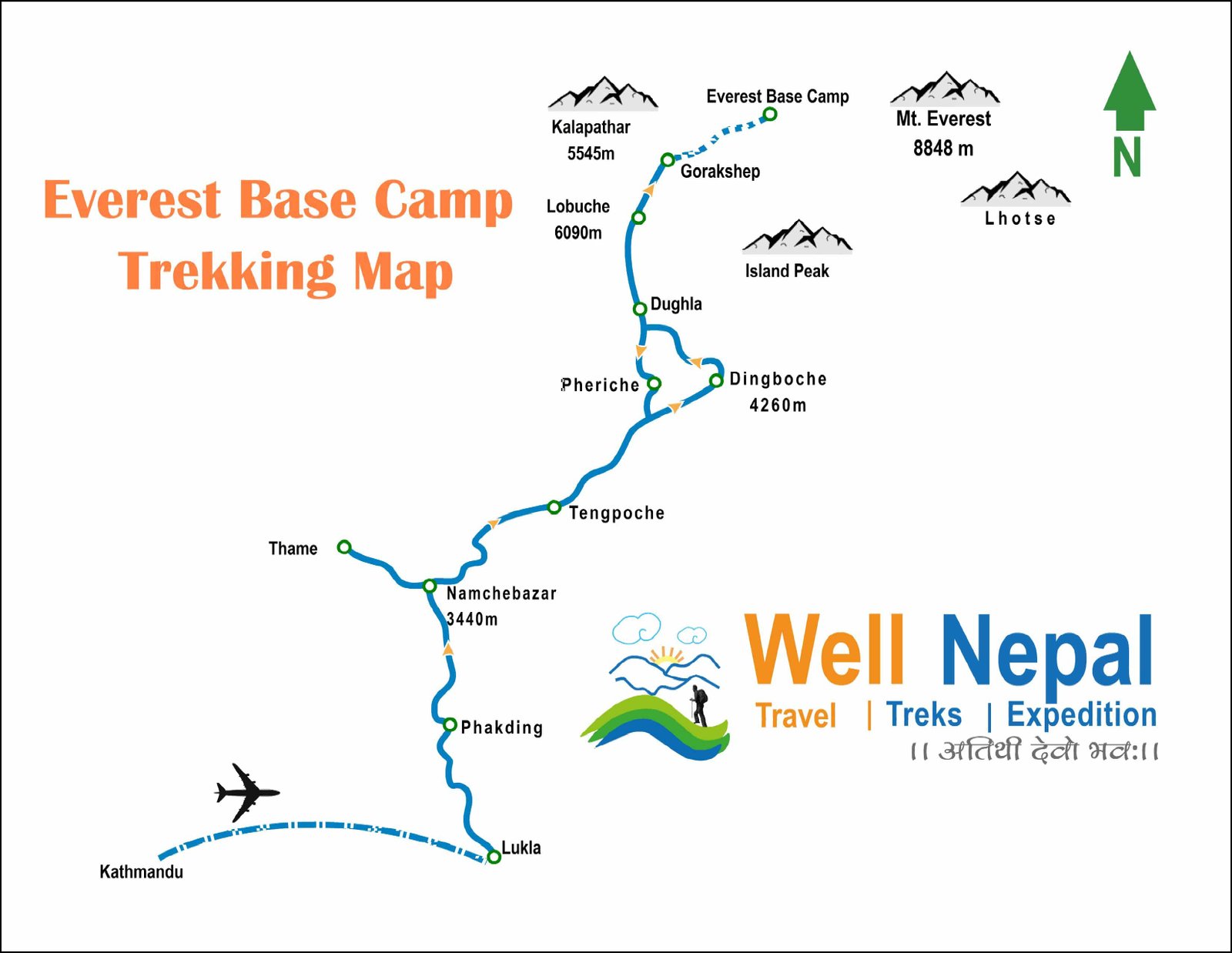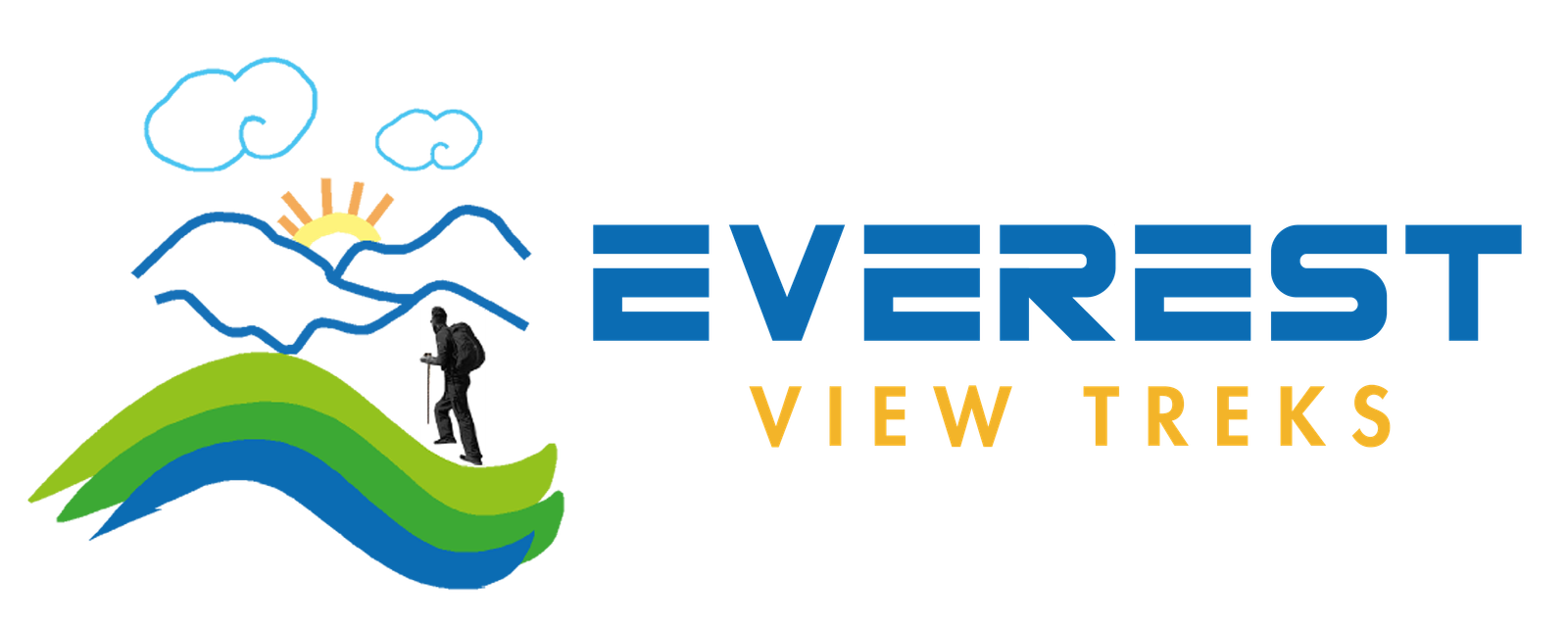Trip At Glance
-
Group Size1-15 pax
-
Max Elevation3860 m
-
GradeEasy
-
TransportationFlight
-
AccommodationHotel and Teahouse
-
Cost1300
-
Trip Length10 Days
-
Best MonthMarch, April, September, October
-
WIFIAvailable
-
Trip ModeHiking/Trekking
-
MealAll Meals on Trek
-
Trekking StyleHiking
-
Start FromKathmandu
-
End PointKathmandu
Trip Overview
The Everest View Trek is one of the most amazing treks through the heart of the most significant region of Everest, which has the world’s renowned giants of mountains. It is for the traveller who wants to taste the Himalayas without the tall order of a physically challenging trekking adventure.
Beginning from the spectacular town of Lukla, where helicopters are famous, the trek initially moves through dense forests and then through Sherpa country. During the trekking, groups obtain astonishing views of giants such as Everest, Lhotse, or Ama Dablam that make all trip moments inappreciable, framing the magnificent artwork of the Himalayas.
The cultural side of the Everest View trek is also precious. It includes sightseeing at monasteries like Tengboche, where people can see daily Sherpa life with numerous ceremonies, all set against stunning views of the mountains.
Namche Bazaar is a colourful market street on the hills surrounded by white mountains. Built by the Sherpa people, it allows trekkers to experience the Sherpa culture and their hospitality during the trek.
HIGHLIGHTS
- Spectacular Mountain Views: Throughout the trek, enjoy unparalleled views of Everest, Lhotse, and other towering peaks from various vantage points.
- Cultural Immersion: Experience Sherpa culture firsthand, visit monasteries, interact with locals, and explore traditional villages along the route.
- Namche Bazaar: Discover the bustling Sherpa town of Namche Bazaar, renowned for its unique blend of cultural heritage and modern amenities.
- Tengboche Monastery: Visit the historic Tengboche Monastery, a spiritual centre offering panoramic mountain views and a serene atmosphere.
- Scenic Flight to Lukla: Begin your adventure with a thrilling flight from Kathmandu to Lukla, enjoying aerial views of the Himalayas and rugged terrain below.
- Sagarmatha National Park: Trek through the pristine landscapes of Sagarmatha National Park, a UNESCO World Heritage site renowned for its biodiversity and natural beauty.
Detailed Itinerary
Day 1 Arrival in Kathmandu and Transfer to the Hotel
At the airport in Kathmandu, Tribhuvan International Airport, you will be greeted by our tour agent, who will escort you to the hotels in Kathmandu. Kathmandu is Nepal's capital city, bringing an amalgamation of temples, markets, and streets full of activities.
Once you arrive in Kathmandu and check into your hotel, and maybe have dinner/lunch or order some food comprising some delicious Nepali local dishes, you can then move out and visit some of the sites such as Kathmandu Durbar Square, Swayambhunath stupa, commonly referred to as Monkey Temple or wander around the Thamel a famous tourist area known for its numerous shops and restaurants.
Meals
Lunch, Dinner |
Accomodation
Hotel in Kathmandu |
Altitude
1400 |
Day 2 Flight from Kathmandu (1,400 m) to Lukla (2,860 m) & Trek to Phakding (2,610 m)
After waking up early, you will be on a spectacularly scenic flight from Kathmandu to Lukla, a small strip at such a high mountain altitude. The plane flight lasts 30 minutes and allows you to see the beautiful Himalayas and even Everest if the weather is fine.
When you arrive at Lukla (2,860m), the starting point of the trek, which is surrounded by the Everest region, you will be met by your trekking crew. The first day’s journey to Phakding (2,610m) is comparatively easy and passes through the colourful Sherpa settlements and the magnificent Dudh Koshi River.
On the way, you experience the local Buddhist civilization by walking in front of prayer wheels, mani stones, suspension bridges, and prayer flags. For the night, you will stay at a delightful tea house in Phakding - your first indication of the enchanting days ahead in the Himalayas.
Meals
Breakfast, Lunch, Dinner |
Accomodation
Teahouse |
Altitude
2610 |
Day 3 Trek from Phakding (2,610 m) to Namche Bazaar (3,440 m)
Our journey today explores the Sagarmatha National Park, a bio-cultural reserve on the World Heritage list. Its slopes are relatively steep, although there are some slopes. Several suspension bridges over the gushing rivers, and the trail encircles several forests containing rhododendrons, pine, and fir.
As you ascend, you can view other snow-capped mountains, such as Thamserku (21801 ft) and Kongde Ri (20319 ft).
Namche Bazaar is one of the largest Sherpa towns in the Eder Everest region, and it will take about 5-6 hours of trekking to reach there. Namche is a lively place where most trekking parties are based. You can meet Sherpas and other locals, exchange products and news at the Wednesday market, and drink tea in small restaurants.
Here, you will spend two nights resting, familiarising yourself with the high altitudes, and window shopping around the town’s closely-knit zones with interesting nylon-aided shops selling trekking equipment, jewellery and other souvenirs, fruits, etc.
Meals
Breakfast, Lunch, Dinner |
Accomodation
Teahouse |
Altitude
3440 |
Day 4 Acclimatization and Exploration Day in Namche Bazaar
It is a full day for acclimatization to minimize the impacts of Acute Mountain Sickness prevalent at high altitudes. You can take an hour's walk to the Everest View Hotel or Syangboche airport for the stunning view of the Hillary Mount Everest (8,848m.) & other Himalayan ranges.
In its stead, you can tour the Sherpa Cultural Museum to get acquainted with the diverse culture and history of Sherpas in the Mount Everest trekking business. Day 5 will be spent exploring Namche Bazaar, having a picnic lunch, and drinking some tea before returning to a tea house for the night.
Meals
Breakfast, Lunch, Dinner |
Accomodation
Teahouse |
Altitude
3440 |
Day 5 Trek from Namche Bazaar (3,440 m) to Tengboche (3,860 m)
Crossing Namche Bazaar, the track rises gently through the rhododendron and juniper field, where wildlife like musk deer and colourful Hill Thar are occasionally seen. Finally, there is Tengboche (3,860m), which offers a view of the Tengboche Monastery, the largest Monastery in the Everest area and a religious place for the Sherpa community.
Situated at a vantage point overlooking the world’s tallest peak, Tengboche provides exceptional views of Makalu, which measures 8,516m, and Ama Dablam, which measures 6,812m. Tengboche is a picturesque village beside the Dudhkoshi River, and beneath Ama Dablam is a vital monastery that offers a time for prayer in the evening and a beautiful night's stay in this region.
Meals
Breakfast, Lunch, Dinner |
Accomodation
Teahouse |
Altitude
3860 |
Day 6 Trek from Tengboche (3,860 m) to Khumjung Village (3,790 m)
Leaving Tengboche, the path passes through airy pine forests and suspension bridges over the Dudh-Kosi River. There are several such villages on the trek, such as Deboche and Pangboche, where typical Sherpa houses are painted with prayer flags.
Following the same trail, you will come across the village of Khumjung (3,780m), which resides at the bottom of the mountain called Khumbila, the ‘God of the Khumbu’. One can visit the Hillary school here, which was established by Sir Edmund Hillary, and a monastery at Khumjung, which stores a scalp of the Yeti.
Feel the homely Sherpa welcome and breathtaking vistas of the great mountain before spending the night in a lodge known as the tea house.
Meals
Breakfast, Lunch, Dinner |
Accomodation
Teahouse |
Altitude
3780 |
Day 7 Trek from Khumjung Village (3,790 m) back down to Phakding (2,610 m)
Today, to reach Phakding, you will retrace your steps with views of the Kvnj Tschugga re-visited as you walk down through the forested areas and cross high suspension bridges across the Dudh Koshi River. The descent is also an excellent opportunity for travellers to cast one final look at the beautiful landscapes of the Everest zone on the trip back to Phakding.
Arriving in Phakding is another successful accomplishment of your trekking adventure, and it is the perfect time to join your trekking crew and other trekkers, enjoy a delicious meal together, and share experiences of the day or the entire trekking experience.
Meals
Breakfast, Lunch, Dinner |
Accomodation
Teahouse |
Altitude
2610 |
Day 8 Trek from Phakding (2,610 m) back up to Lukla (2,860 m)
Your last day involves descending from the mountains back to Lukla, following the steps along the Dudh Koshi River as you did on the first day, and admiring the area's beauty on your way down. The trail provides a view into the pine and rhododendron-filled forests full of singing birds and crunching leaves.
The terraced fields and the peaks of mountains in the distance can be seen while approaching Lukla, and the reminisce of the trekking adventure is cherished.
On reaching Lukla, you part with your trekking staff, rest, and stay in the local tea house in Lukla, thinking of so many experiences and friendships you have encountered during the trekking period.
Meals
Breakfast, Lunch, Dinner |
Accomodation
Teahouse |
Altitude
2860 |
Day 9 Flight from Lukla (2,860 m) back down to Kathmandu (1,400 m) or Manthali
Early in the morning, board a thrilling flight from Lukla back to Kathmandu or Manthali, which offers a bird's-eye view of the Himalayan peaks you've recently explored.
Upon arrival in Kathmandu, transfer to your hotel and enjoy leisurely exploring the city's cultural landmarks or indulging in last-minute souvenir shopping. Reflect on your Everest View Trek adventure, sharing stories and photos with newfound friends before preparing for your departure from Nepal.
Meals
Breakfast, Lunch, Dinner |
Accomodation
Teahouse |
Altitude
1400 |
Day 10 Departure from Nepal
After breakfast, relying on your flight schedule, enjoy some free time in Kathmandu before transferring to Tribhuvan International Airport for your onward journey. Bid farewell to Nepal, a land of majestic mountains, vibrant cultures, and warm hospitality, carrying cherished memories and a deep gratitude for the natural beauty of the Everest region.
Meals
Breakfast |
Accomodation
N/A |
Altitude
1440 |
Cost Included
- Accommodation in Kathmandu is provided with breakfast at a 3-star hotel
- Lodge accommodation during the trek
- Experienced English-speaking trekking guide throughout the trek
- All necessary permits
- Local transfers via private vehicle
- Kathmandu to Lukla and return flight tickets
- Porter for carrying luggage
- All applicable taxes
Cost Excluded
- Nepal entry visa fees
- International or domestic airfare
- Compulsory travel insurance
- Alcoholic beverages, hot and cold drinks
- Lunch and dinner in Kathmandu
- Any additional expenses resulting from unforeseen circumstances such as flight cancellations, personal illness, strikes, political disturbances, etc.
MAP

Things need to know before departure
Frequently Asked Questions
1. What is the Everest View Trek?
The Everest View Trek is a captivating journey into the heart of the Everest region, offering awe-inspiring views of the world's highest peaks, including Mount Everest. It's designed for trekkers seeking a shorter trek with breathtaking scenery and insights into Sherpa culture.
2. How long is the Everest View Trek?
The Everest View Trek typically lasts 8-10 days, including flights to and from Lukla. This duration allows for a comfortable pace, ensuring proper acclimatization and enjoying the stunning landscapes.
3. What is the highest point reached during the Everest View Trek?
The trek reaches its highest point at Tengboche (3,860 meters), where trekkers can visit the famous Tengboche Monastery, surrounded by panoramic views of Everest, Lhotse, and Ama Dablam.
4. Do I need prior trekking experience for the Everest View Trek?
Prior trekking experience is not mandatory, but reasonable fitness and preparation for high-altitude trekking is recommended. The trek involves moderate ascents and descents, sometimes physically demanding.
5. When is the best time to do the Everest View Trek?
The optimal times for the Everest View Trek are during the pre-monsoon (spring) months from March to May and post-monsoon (autumn) months from September to November. These periods offer clear skies, favourable weather conditions, and vibrant landscapes.
6. What permits are required for the Everest View Trek?
You need two main permits to hike in the Everest region: the Sagarmatha National Park entry permit and the TIMS (Trekkers' Information Management System) card. These permits ensure your entry into the protected area and help manage trekker information.
7. How difficult is the Everest View Trek?
The Everest View Trek is considered moderate in difficulty. While it doesn't involve the extreme altitudes or technical challenges of higher altitude treks, it does require stamina for daily hiking over varied terrain. Proper acclimatization stops and gradual ascent help mitigate altitude-related risks.
8. What kind of accommodation can I expect during the Everest View Trek?
Accommodation on the Everest View Trek is in basic but comfortable tea houses or lodges. Rooms generally have twin beds and shared bathrooms. Some tea houses may offer hot showers for an additional cost.
9. Are meals included during the Everest View Trek?
Yes, meals are included during the trek (breakfast, lunch, dinner). The menu at tea houses provides a variety of meals, including Nepali dal bhat (rice and lentils), pasta, noodles, soups, and other local and international dishes. Vegetarian options are readily available.
10. Is drinking water available along the Everest View Trek?
Bottled water is available for purchase at tea houses along the trekking route. It is better to bring a refillable water bottle and use water purification tablets for streams and taps.
11. Are there ATMs or banking facilities on the Everest View Trek route?
There are no ATMs beyond Lukla, so it's recommended that you carry enough Nepali rupees (cash) for the entire trek. Some tea houses may accept credit cards, but this cannot be guaranteed, so money is essential for purchasing snacks, drinks, and souvenirs.
12. What should I pack for the Everest View Trek?
Packing essentials include clothing suitable for varying temperatures (including a warm jacket and waterproof outer layers), sturdy trekking boots, a comfortable day pack, a sleeping bag (if not provided), sunscreen, sunglasses, toiletries, and any personal medications.
13. Is there mobile network coverage and internet access during the Everest View Trek?
Mobile network coverage is known in most parts of the Everest region, particularly in Namche Bazaar and other larger villages. While internet access is open in some tea houses for a fee, the connection may need to be faster and more reliable due to the remote mountainous terrain.
14. What are the risks and challenges of the Everest View Trek?
The main challenges include altitude sickness, which can affect trekkers due to rapid ascent. Proper acclimatizationAcclimatizing, staying hydrated, and recognizing symptoms such as headache and nausea are essential. Weather conditions can also change rapidly, affecting flight schedules and trekking plans.
15. Are there opportunities for cultural experiences during the Everest View Trek?
The Everest View Trek offers opportunities to immerse yourself in Sherpa culture and traditions. You can visit monasteries, interact with local Sherpa communities, and learn about their unique way of life, including their connection to mountaineering and the Everest region.
16. How do I prepare for altitude sickness during the Everest View Trek?
To minimize the risk of altitude sickness, it's important to acclimatize gradually by following the recommended itinerary, staying hydrated, eating nutritious meals, and recognizing symptoms early. If a healthcare professional advises, carry medications like acetazolamide (Diamox) as a preventive measure.
17. Can I extend my trek or customize the itinerary of the Everest View Trek?
Yes, some trekking agencies offer customizable itineraries to suit your preferences. You can extend your trek to visit additional villages and viewpoints or combine it with other treks in the Everest region, such as the Everest Base Camp Trek.
18. What safety measures are in place during the Everest View Trek?
Trekking guides are qualified in first aid and altitude sickness management. They carry basic medical kits and have access to emergency evacuation services if needed. Always trek with a licensed guide for safety and support.
19. What is the environmental impact of the Everest View Trek?
Sustainable trekking practices are encouraged to minimize environmental impact. This includes carrying out all waste (including non-biodegradable items), respecting local customs and wildlife, and using lodges that promote eco-friendly practices.
20. What is the best way to book the Everest View Trek?
It is recommended that you book through a reputable trekking agency in Nepal. They can arrange permits, flights, accommodation, and a licensed guide, ensuring a smooth and enjoyable trekking experience in the Everest region.
Cotact Us
Everest View Treks
9779851136944 , info@everestviewtreks.com , Galkopakha Marg, Kathmandu




